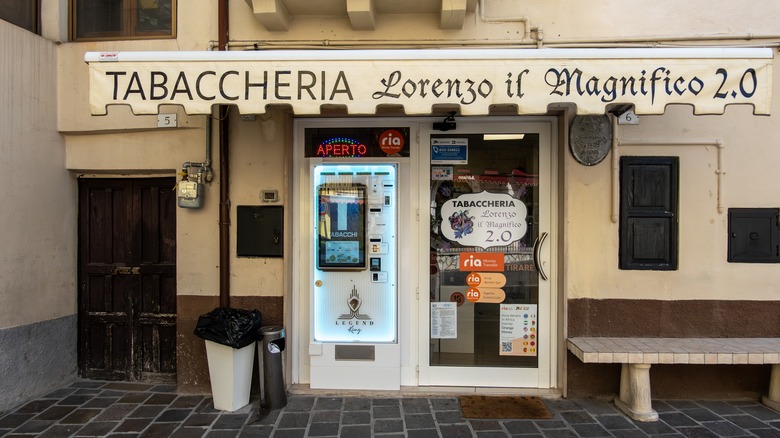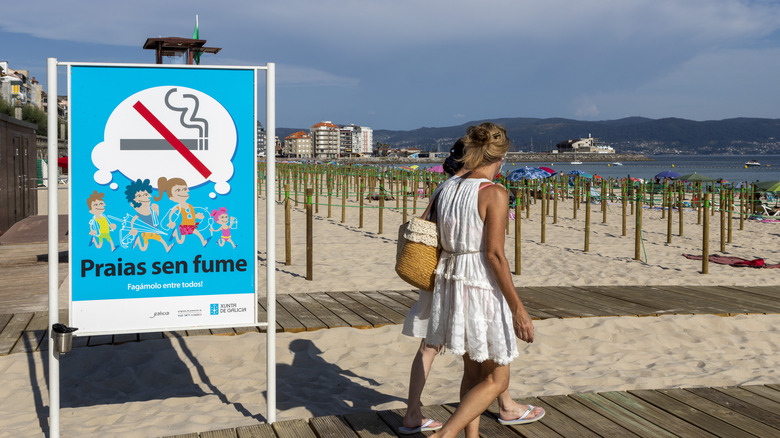The Stinky Habit American Tourists Notice Is A Lot More Common In Europe
When American tourists venture across the Atlantic, they may catch a whiff of one stinky habit that is a lot more common in Europe: smoking. It's not uncommon to see people lighting up in outdoor cafes, public squares, and at the entrances of buildings. In some countries, like Italy and Germany, you can even buy cigarettes from vending machines. For many Americans, the sight of cigarettes and the pervasive smell of tobacco can be quite surprising, if not off-putting. Smoking has been increasingly stigmatized in the U.S. over the past few decades. After all, long gone are the days when doctors would smoke while treating patients, discos were hazed with some 7,000 cigarette chemicals, and Hollywood glamorized the habit.
@christian.grossi you would never see this back in the United States #fyp #tellme #stitch #traveltiktok #backpacking #romania
Rigorous public health campaigns, stringent regulations, and a growing social awareness about the dangers of tobacco have all, thankfully, contributed to a significant reduction in smoking rates. Today, only about 11.5% of American adults smoke, as per the CDC, while around 5.8% smoke vapes, (which you can take through the TSA, by the way). In the U.S., tobacco can only be sold to individuals over 21, and most public spaces, including restaurants, bars, and parks, are smoke-free. Europe presents a very different picture. Despite similar awareness of the health risks, smoking remains a prominent part of daily life in many European countries. This divergence can be quite jarring for American tourists who are accustomed to less in-your-face, or in-your-nose, tobacco use. Ultimately, a combination of historical, cultural, economic, and legal factors are to blame.
Cigarette smoking in Europe: statistics and reasons
The smoking rates in Europe vary significantly from country to country, but overall, they are generally higher than in the United States. According to a global WHO survey, over half of the 20 countries with the highest smoking rates are located in Europe. This top 20 list included countries where tobacco use was prevalent among at least 32.9% of the adult population, compared to the average of 21.9% in the U.S.
For instance, in countries like Greece and Montenegro, nearly half the population smokes. In Spain and Italy, the rates are under 25% but still notably higher than in America. Even countries with strong anti-smoking campaigns, such as Ireland and the Netherlands have slightly higher smoking rates compared to the United States. According to data collected by Eurostat, 19.7% of the population within the European Union smokes tobacco daily, while 1.7% smokes electronic cigarettes.
Why all the smoke? In many European societies, the practice has long been associated with socializing and leisure. The café culture, particularly in places like Italy, often includes smoking. Additionally, the historic lack of effective anti-smoking policies has allowed smoking to maintain a stronger foothold in daily life. High taxes on tobacco haven't worked as a deterrent either, as members of the European Union are already used to paying a nearly 40% individual tax rate. Finally, in the U.S., smokers often pay more for life insurance, providing a financial disincentive to smoke, while Europe's broader public health coverage doesn't create the same economic pressure to quit.
Smoking impact on tourists
While Europe has seen significant strides in smoking regulation over the past two decades, the actual scope of these laws can be inconsistent. For example, the European Union has implemented strict tobacco advertising and packaging laws, and many countries have introduced smoking bans in enclosed public spaces. However, enforcement varies widely, and outdoor smoking remains accepted, with patios becoming de facto smoking zones (much to the chagrin of non-smoking patrons). In some destinations like Vienna and Prague, even indoor smoking is still permitted. On a brighter note, some beaches on the islands of Majorca, Menorca, and Ibiza prohibit smoking altogether as a strict law that also applies to tourists.
The cultural shock can be particularly pronounced for travelers from places where smoking is less common in the U.S., such as California or New York City. They may find themselves having to adapt to the more relaxed attitudes in Europe or resort to seeking out smoke-free areas to enjoy their meals or sightseeing. Indeed, one thing tourists should know before dining in Paris is how to ask to be seated in the non-smoking section.
Ultimately, the health implications of smoking are well-documented and acknowledged. Just like their American counterparts, European countries face significant public health challenges related to tobacco — 700,000 people die from tobacco consumption every year, according to the European Commission. However, the cultural entrenchment of smoking means that reducing it may require more than just regulations; it demands a shift in social attitudes and behaviors.


